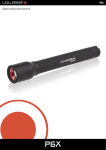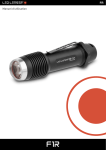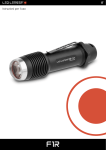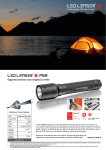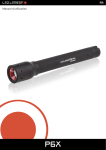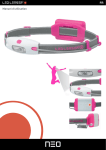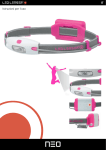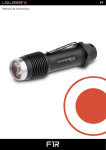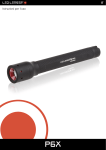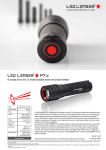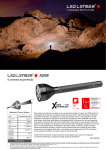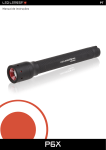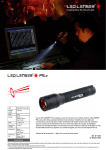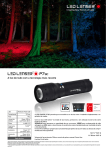Download neo *neo
Transcript
Led Lenser®* EN Operating Instructions * neo Led Lenser®* Table of Contents 1. 1.1 1.2 1.3 1.4 1.5 General Product Information 4 Product Description 4 Versions 4 Scope of Delivery 4 Range of Use 4 Product Properties 5 2. 2.1 2.2 2.3 2.4 2.4.1 Important Notes on Safe Use 6 Information Regarding Headlamp Identification 6 Information Regarding Operating Instructions Identification 6 Warranty 6 Completeness 6 Damage 6 2.5 2.5.1 2.5.2 2.5.3 Purpose of the System 6 Standards and Regulations 6 Intended Use 7 Target Group 7 2.6 Disposal 7 3. 3.1 3.1.1 3.1.2 3.1.3 Safety Notes 8 Safety Notes Structure 8 Risk of Injuries Markings 8 Damage to Property Markings 8 Marking of Additional Information 8 3.2 3.3 3.4 3.5 Additional Pictograms Regarding Safety Notes 8 Pictograms on the Headlamp 8 Pictograms on the Packing 8 Overview of the Key Safety Notes 8 4. Overview of Terms and Abbreviations 12 5. 5.1 5.2 5.3 5.4 5.5 5.6 5.7 5.8 Operation 13 Adapting the Headband Width 13 Putting on the Headlamp 13 Switching the Headlamp On or Off 13 Using the Lighting Functions 14 Replacing the Batteries 15 Cleaning 15 Checks 16 Warranty 16 6. Technical data 17 EN Operating instructions NEO_V.01 | 7/31/2014 2 Led Lenser®* Thank you We are delighted that you have decided in favor of one of our products. In these Operating Instructions you will find notes regarding safety and operation to help you to familiarize yourself with your new product. Carefully read these Operating Instructions prior to using this product. They should be kept and handed over to third parties when passing on the product to third parties. This also helps to ensure that you obtain maximum benefit from the product, get your questions answered and avoid incorrect operation. Above all, observe the warning and safety instructions and dispose of the headlamp, batteries/battery packs packaging materials properly. EN Operating instructions NEO_V.01 | 7/31/2014 3 Led Lenser®* 1. General Product Information 1 2 3 4 5 6 7 1 89A C D B 6 1.1 ① Headlamp head ② Adjustable band range ③ Band adjustment ④Headband ⑤ Cable ⑥ Anatomically formed battery cover (rubber) ⑦ Sliding cable duct ⑧ On/Off switch ⑨ Front white light-emitting diode (LED) ⑩ LED cover ⑪ Headlamp head cable attachment ⑫ Battery box ⑬ Rear red light-emitting diode (LED) ⑭ Cable pull relief ⑮ Battery box cable attachment 1.2 E Product Description Versions Designation Color Article no NEO Blue 6010 Green 6011 Pink 6012 Orange 6013 Yellow 6014 F 1.3 Scope of Delivery • Headlamp NEO, • Blister pack, • General safety precautions and warnings, • NEO quick initial start guide, • 3 x AAA 1.5 V batteries. 1.4 Range of Use Suitable for outdoor use. Protected against spray water from all sides (IPX4). EN Operating instructions NEO_V.01 | 7/31/2014 4 Led Lenser®* 1. General Product Information 1.5 1 Product Properties • Extremely low weight, • 16:9 Bright & Wide Beam ② XY --with particularly wide radiation angle ① and --bright illumination, NEO • Smart Light Technology (SLT) ③ with --3 different lighting modes (Power / Low Power / Blink) for the front light, --r ear red flashing light (LED) ④ for more safety, • All-side splash-proof housing (IPX4), • Stable cabling with sliding cable duct and pull relief, 2 --compact, aerodynamic shape, • Rear of the headlamp head and battery cover ⑥ adapted to human anatomy, • Simple 1-switch operation ⑤. 3 4 5 6 EN Operating instructions NEO_V.01 | 7/31/2014 5 Led Lenser®* 2. Important Notes on Safe Use 2.1 Information Regarding Headlamp Identification hese Operating Instructions are designed exclusively for the headlamps and T accessories identified using the following specifications: Identification – Type designation: 2.2 NEO Information Regarding Operating Instructions Identification All pages are marked as a indication of the currency of the Operating Instructions using the type designation containing the 2-digit version number, release status and country designation(s): Release – Marking: – Status at: NEO_V.01 7/31/2014 This marking is binding for the validity of the Operating Instructions and should not be removed regardless of the type of publication (printed, data format or in excerpts). 2.3 Warranty WarrantyLED LENSER ensures the safety and proper functioning of the headlamp only under the condition that: • The headlamp is only used according to the intended purpose and operated and maintained in accordance with the information contained in these Operating Instructions, • Only original spare parts or accessories approved by LED LENSER are used, • The headlamp is not modified in any way. 2.4 Completeness Check the headlamp for completeness and any damage before installation. • Unpack all components for checking and perform a visual inspection. • The components can be identified using these Operating Instructions. 2.4.1 Damage Please contact the vendor / distributor in the event of damage or missing items. 2.5 Purpose of the System 2.5.1 Standards and Regulations Headlamp, accessories and Operating Instructions comply with the requirements of following standards and regulations: • General Product Safety Directive 2001/95/EG / Product Safety Act (GPSG), • Directive 2014/30/EU of the European Parliament and the Council on the Harmonization of the Laws of the Member States on electromagnetic compatibility, • Regulation (EC) No 1907/2006 of the European Parliament and the Council on the Registration, Evaluation, Authorization and Restriction of Chemicals (REACH), • DIN EN 62471:2009 Photobiological safety, • Directive 2011/65/EU "Restriction of the use of certain hazardous subEN Operating instructions NEO_V.01 | 7/31/2014 6 Led Lenser®* 2. Important Notes on Safe Use stances (RoHS) in electric and electronic devices" of the European Parliament and the Council, • IEC 82079-1:2012 - Preparation of instructions for use – Structuring, content and presentation - Part 1: General principles and detailed requirements. 2.5.2 Intended Use NEO is a high-performance headlamp with a light cone. It is designed to enable you to see and be seen in the dark, for use as emergency light or to read in the dark. • The headlamp is suitable for continuous operation. • The headlamp is suitable for outdoor use. • Any use beyond the above-mentioned conditions is considered to be improper use. The user is liable for any damage resulting from such use. 2.5.3 Target Group he headlamp is suitable for persons above 12 years of age without any T limitations. Persons with physical or technical limitations and children between 6 and 11 years may only use the headlamp under the supervision of a parent or guardian. 2.6 Disposal • The headlamp must be disposed of at a suitable place of disposal for recycling electric and electronic equipment according to the country-specific regulations. • Submit used batteries/battery packs to a local battery collection point or anywhere where batteries/battery packs are sold in accordance with country-specific regulations. EN Operating instructions NEO_V.01 | 7/31/2014 7 Led Lenser®* 3. Safety Notes 3.1 Safety Notes Structure Important notes are marked with pictograms and signal words in these Operating Instructions. 3.1.1 Risk of Injuries Markings ignal words, such as DANGER, WARNING or CAUTION designate the grading S of a potential risk of injuries. The different triangle symbols emphasize the level of risk optically. 1 Danger DANGER indicates an immediately dangerous situation that, if not avoided, may lead to death or serious injury. 1 Warning ARNING indicates a potentially dangerous situation that, if not avoided, may W lead to death or serious injury. 1 Caution CAUTION indicates a potentially dangerous situation that, if not avoided, may lead to slight or minor injury. 3.1.2 Attention ATTENTION indicates a potentially dangerous situation that, if not avoided, may lead to property damage. 3.1.3 Note Damage to Property Markings Marking of Additional Information OTE gives you added information and helpful tips on safe and efficient use of N the headlamp. 3.2 Additional Pictograms Regarding Safety Notes Explosion hazard: warns of explosion of the batteries caused by strong heating. Risk of glare: warns of glare caused by light beam with high brightness. Follow the Operating Instructions: refers to compliance with these Operating Instructions. 3.3 Pictograms on the Headlamp Optical radiation: warns of potential damage to the retina caused by photobiological radiation. 3.4 Pictograms on the Packing CE marking: confirms conformity with the applicable standards and legal provisions. 3.5 Overview of the Key Safety Notes • The following safety notes should be read carefully before using the headlamp! • If the headlamp is passed on to another person, the operating instructions and these precautions and warnings must also be passed on. • If there are warnings or warning symbols on the item, they may not be removed. EN Operating instructions NEO_V.01 | 7/31/2014 8 Led Lenser®* 3. Safety Notes Health risk 1 Warning IMPAIRMENT CAUSED BY THE FLASHING FUNCTION When using the flashing function, dizziness, vision-impairment, convulsions, loss of consciousness, disorientation or cramps may occur. Therefore: • In the event that one of the symptoms mentioned above occur, immediately switch off the flashing function/headlamp. • People who suffer from reflex epilepsy (photosensitivity) when exposed to flashing lights may not use the flashing function. What to do: →→ In the event that symptoms occur, switch off the headlamp and consult a doctor. 1 Warning ACCIDENT/INJURY RISK FOR CHILDREN Do not permit the headlamp to be operated by children, by persons under the influence of medication or drugs, or by persons with physical or mental disabilities/illnesses, as there is a risk of injury to the eyes and a risk of accidents. Therefore: • Do not allow children to play with the headlamp. • Persons with limitations should only use the device under the supervision or instruction of a responsible person. 1 Warning RISK OF GLARE The strong glare-effect of the headlamp may, however, cause temporarily limited vision and after-images that may cause irritation, disturbances or accidents. Therefore: • N ever ever look directly into the beam of light or illuminate the eyes of another person, do not carry out pupil testing. • Do not point the beam of light at people or animals as they may be dazzled. • Do not use any optically highly-focused devices to observe the beam of light. • Do not use multiple headlamps at once as this increases the optical radiation and thus increases the risk of retina damage. • Commercial users or users in the public services are to be instructed in the applicable laws and regulations. What to do: →→ If a beam of light hits the eyes, deliberately close the eyes and move the head out of the beam of light. EN Operating instructions NEO_V.01 | 7/31/2014 9 Led Lenser®* 3. Safety Notes 1 Caution RISK OF INJURY Do not wear the headband around the neck. Do not use headlamp or accessories if they are damaged, since there is a risk of injury. Therefore: • T ake damaged parts out of operation and replace or have them repaired professionally. 1 Caution PHOTOBIOLOGICAL SAFETY (EYE SAFETY) The headlamp is classified in risk group 2 (medium risk) in accordance with standard IEC 62471 and thus extends beyond the “free group”. The risk of damage to the retina caused by optical radiation (blue light from 400 nm to 780 nm) is inherent, yet the thresholds are considerably undercut. Note ELECTROMAGNETIC COMPATIBILITY he flashlight meets the requirements of the 2014/30/EC guideline with T regard to electromagnetic compatibility. Modifications / Repairs 1 Caution DO NOT MAKE ANY MODIFICATIONS/REPAIRS Repairs, additions or modifications to the flashlight are not permitted as these may lead to damages to the headlamp or a risk to persons: Therefore: • LEDs cannot be replaced. • Do not open the headlamp unless this is expressly permitted by the operating instructions. • Never carry out repairs yourself, always take the headlamp to a specialist dealer. Batteries and battery packs 1 Warning EXPLOSION OR RISK OF ACID BURNS Batteries/battery packs can explode as a result of strong heating. Leaking of battery fluid can cause chemical burns. Therefore: Do not expose batteries and battery packs ... • To direct sunlight or great heat over an extended period of time. • Do not heat them or throw them into the fire and avoid heat buildup in the headlamp by covering it, for instance. • Do not throw them into water or leave out in the rain. • Do not swallow them. • Do not open, damage or short-circuit them. • Only recharge them if they are labeled accordingly. • Do not store them within the reach of children. • Only insert them into the battery compartment in accordance with the EN Operating instructions NEO_V.01 | 7/31/2014 10 Led Lenser®* 3. Safety Notes displayed markings (+/-). • R emove from the headlamp if you will not be using it for some time or if they are empty. What to do: →→ In the event of leaking batteries, place a cloth underneath and prevent the skin, eyes and mucous membranes from coming into contact with battery fluid. In the event of contact, immediately rinse the affected parts with plenty of clean water and consult a doctor. Attention CHANGING THE BATTERY • S tore batteries/battery packs in a clean, dry place between -10 °C and + 25 °C. • Only insert batteries in accordance with the markings (+/-). • If necessary, clean the battery and/or headlamp contacts before inserting. • Never use new and used batteries/battery packs together, • Only use high-quality batteries of the same type. • Always change all batteries at the same time. Attention RISK OF SHORT-CIRCUITING In order to avoid the risk of a short-circuit when recharging: • Do not touch the charging contacts with damp or metal objects. • If need be, clean the charging contacts. • Only recharge headlamp/battery packs in dry rooms. Attention MALFUNCTIONING OF THE HEADLAMP Always check the headlamp for functionality prior to use and, to be on the safe side, carry a replacement lamp and sufficient replacement batteries with you. If the headlamp does not function or does not function correctly, proceed as follows: • Check whether all the batteries/battery packs have been inserted with the poles (+/-) the correct way round and are fully charged. • Check the flashlight or battery/battery pack contacts and clean if necessary. What to do: →→ To use all the functions again, insert new batteries or recharge the battery packs. Disposal / environmental protection Attention DISPOSAL/RECYCLING Headlamps and used batteries/battery packs may not disposed of in the household or residual waste. They must be disposed of in accordance with national legal requirements. The materials are recyclable according to their labeling. Reuse of the materials makes an important contribution toward environmental protection. EN Operating instructions NEO_V.01 | 7/31/2014 11 Led Lenser®* 3. Safety Notes Therefore: • S ubmit headlamps in to a local collection point for the recycling of electrical and electronic devices. • Submit used batteries/battery packs to a local battery collection point or anywhere where batteries/battery packs are sold. • Batteries, lithium batteries in particular, and battery packs may only be disposed of when discharged. • Separate the packaging materials and dispose of correctly. 4. Overview of Terms and Abbreviations The following technical terms / abbreviations are used in these Operating Instructions: SLT Smart Light Technology LED Short for Light-Emitting Diode Battery pack Short for rechargeable battery, i.e. rechargeable energy source EN Operating instructions NEO_V.01 | 7/31/2014 12 Led Lenser®* 5. Operation 1 2 3 4 5 6 7 5.1 Adapting the Headband Width 1. In order to extend the headband ④ further, hold the band adjustment ③ between the fingers and pull the headband ④ in direction of the battery cover ⑥ until the headband ④ has reached the desired length. 2. In order to adjust the headband ④ tighter, hold the band adjustment ③ between the fingers and pull the 8 headband ④ in direction of the lamp head ① on the 6 outermost part of the adjustable band range ② until the headband ④ has reached the desired length. 3. Move the battery box ⑧ with battery cover ⑥ in such a way that the battery box ⑧ is facing the lamp head ①. 4. Move the cable duct ⑦ in such a way that the cable ⑤ is slack against the headband ④. 5.2 Putting on the Headlamp 1. Align the headband ④ in such a way that the cables ⑤ are on the outside. 2. 2. Press the curved lamp head ① rear up against the forehead using one hand. 1. 3. Using the other hand, pull the battery cover ⑥ backward 3. gently and pull it with the headband ④ downward over the back of the head. →→T ake care to ensure that the anatomically shaped rear 8 1 4 5 7 6 of the battery cover ⑥ is in place on the back of the head. 4. If necessary, move the battery box ⑧ with the battery cover ⑥ or cable ducts ⑦ in such a way that the headlamp fits comfortably. 5. Adapt the width of the headband ④ according to Chap. 5.1 as required. 1 9 5.3 Switching the Headlamp On or Off 1. Press the On/Off switch ⑨ on top of the lamp head 1x to switch the headlamp ① on. 2.Press the On/Off switch ⑨ on top of the lamp head once more to switch the headlamp ① off. Note Switching off The headlamp can only be switched off after 2-3 seconds because the lighting functions would otherwise be enabled. EN Operating instructions NEO_V.01 | 7/31/2014 13 Led Lenser®* 5. Operation 1 5.4 2 3 Using the Lighting Functions The headlamp has 2 LEDs, a white LED ③ on the front (in the lamp head ①) and a red LED ⑤ on the rear battery box ④. This enables a white front light for illumination and an optional flashing red warning light at the rear. 4 5 6 1.Press the On/Off switch ② quickly several times in order to use the lighting functions. →→ Each time you press the switch, you activate the next lighting function. On/Off switch press 7 White front light Red rear light 1x on, very bright light off 2x very bright light flashing 3x dimmed light flashing 4x flashing flashing 5x off off 1x 2x 3x 4x 5x EN Operating instructions NEO_V.01 | 7/31/2014 14 Led Lenser®* 5. Operation 1 5.5 2 Replacing the Batteries The battery box ① is located at the rear of the headlamp for optimal weight distribution. 1.Pull back the flexible battery cover ② of the battery box ① on the side labeled ”Open” to replace the batteries. 2.Carefully pull out the battery box ① and cable ④ from the battery cover ② and twist the battery box ①. 3.Removed the empty batteries and dispose of them in accordance with national legislation. 4 3 1 4.Insert the new batteries ⑤ in accordance with the (+/-) 2 markings in the battery box ①. 1. 5.Push the battery box ① into the battery cover ⑥ while inserting the cable attachment into the corresponding opening ③ of the battery cover ②. 6.Put the flexible battery cover ② over the battery box ① on the side marked with ”Open”, slightly depressing the cover ② such that it closes flush. 1 Caution Explosion hazard lways insert the batteries according to the A (+/-) markings as there is otherwise a risk of damaged or even exploding batteries. 2. 5.6 Cleaning The following should be noted for cleaning: • Clean the headlamp and its accessories only dry using a lint-free cloth. • If the headlamp comes into contact with salt water, remove the salt water immediately and fully with a lint-free cloth. • Wash the headband in clear water and let it dry before use. • Do not use any chemical or solvent-based detergents or disinfectants. 3. 5 Attention Damage to surfaces Solvents can damage surfaces or decompose materials! 4. Therefore: • D o not use any cleaning agents or disinfectants. • Do not use scouring agents. • Do not use gasoline, paint thinners or similar products. EN Operating instructions NEO_V.01 | 7/31/2014 15 Led Lenser®* 5. Operation Attention Warranty exemption No warranty will be assumed for damage resulting from the use of inappropriate cleaning agents or disinfectants. 5.7 Checks very product is prone to wear over time. Annually, and prior to each use, E check the safety and function of the headlamp as well as the batteries/battery packs. Attention Replace and dispose of damaged or old batteries / battery packs. --------------------------------------------------------------------------------------------Do not use defective headlamps or accessory parts and contact vendor / distributor. 5.8 Warranty Our products are subjected to stringent quality control. Please contact the vendor / distributor in the event that this headlamp does not function according to expectations. Attention Improper repairs Unauthorized repair shopsThe device may only be repaired by an authorized repair shop, otherwise legal warranty will become void. EN Operating instructions NEO_V.01 | 7/31/2014 16 Led Lenser®* 6. Technical data NEO Parameter value Value LED 1 x High End Power LED Weight 54 g (without batteries) / 80 g Batteries 3 x AAA 1.5 V, use of battery pack (NiMH) possible Energy tank*** 5.4 Wh Lighting modes Power Low Power Flash Luminous flux* 90 lm 20 lm 20 lm Burning life** 10 hours 40 hours 100 hours Beam distance* 10 m Waterproof IPX4 * Luminous flux (lumen) or maximum beam distance (in meters) is measured using the setting specified in the table on switching on with a set of fresh alkaline batteries. These are average values that may deviate by +/- 15% in individual instances in accordance with chip and batteries. ** Average burning life up to a luminous flux of 1 lumen. *** Calculated value of the capacity in Watt hours (Wh). This applies to the fully charged batteries or battery pack(s) contained in the relevant article in the delivered state. EN Operating instructions NEO_V.01 | 7/31/2014 17 EN Operating instructions NEO_V.01 | 7/31/2014 * ZWEIBRÜDER® OPTOELECTRONICS GMBH & CO. KG Kronenstr. 5-7 • 42699 Solingen • Germany Tel. +49 212 / 5948 - 0 • Fax +49 212 / 5948 - 200 [email protected] • www.zweibrueder.com


















